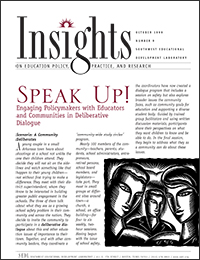What Are Some Deliberative Dialogue Models?
What Are Some Deliberative Dialogue Models?
For information about a wide variety of public engagement and dialogue models, visit the Civic Practices Network (CPN) Web site (http://www.cpn.org). The models listed here are examples that meet the definition of deliberative dialogue.
| Who to Contact | The Process | |
| Study circles bring together members of a community in small groups of 5-15 individuals who agree to meet several times (usually 4-5 sessions) to work through a social or political issue in a democratic, nonpartisan, and collaborative way. Discussion materials provide a common starting point for the discussion and help participants consider a number of different viewpoints about the issue. Trained facilitators help guide the discussion. The SCRC model of community-wide study circles involves multiple study circles in a large-scale, broad-based effort across a community. Representatives of community institutions collaborate to involve ordinary citizens from all parts of the community in open discussions about an issue of importance to them. After the conclusion of the study circles, results may be shared with the community, and action ideas may be considered and developed in an “action forum.” | |
| National Issues Forums are locally-sponsored discussion groups that bring people together to talk about important issues. Forums range in format from small study circles which meet for several sessions to large community gatherings modeled on New England town meetings. All forums use nonpartisan issue books designed by NIF to guide dialogues on specific issues and help participants learn about the issue. The structured discussions are led by trained moderators who help participants weigh solutions to problems and the arguments for and against them. The results of the forums are shared with national and local leaders. In addition, citizens who have attended a forum often decide to continue to work together to try to solve problems in their community. | |
| Citizens jury panels consist usually of 18 randomly selected and demographically representative individuals who meet for four or five days to carefully examine an issue of public significance. Jurors hear from a variety of expert witnesses during moderated hearings. They then deliberate together on the issue and present recommendations to the public. |
Next Page: What Might Deliberative Dialogue Offer to Policymakers, Educators, and the Public?

